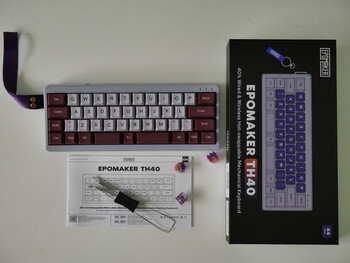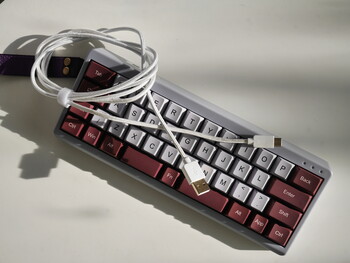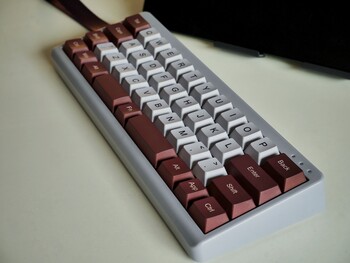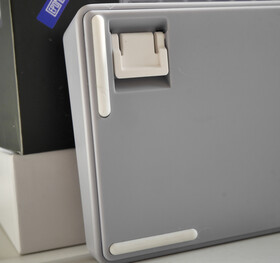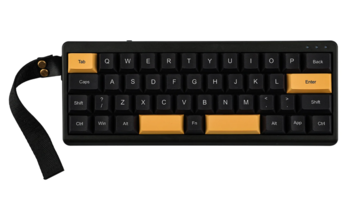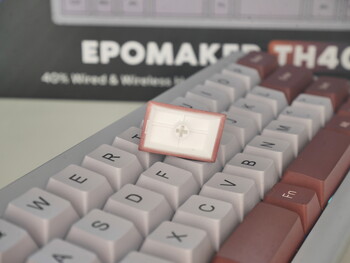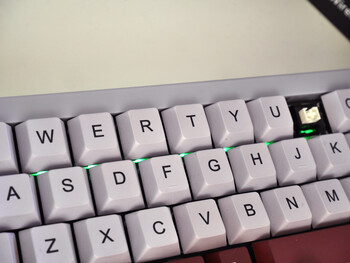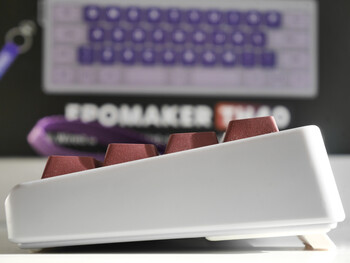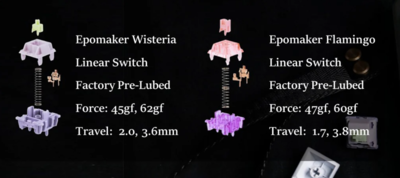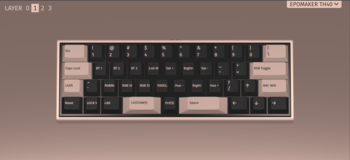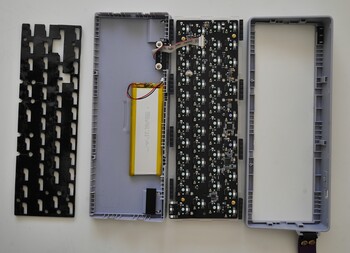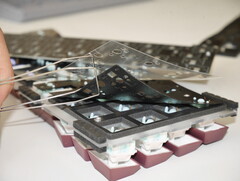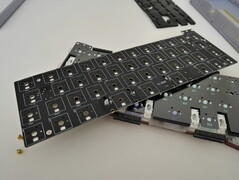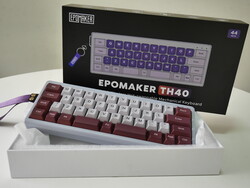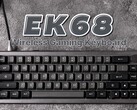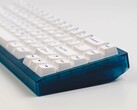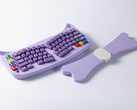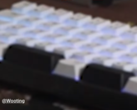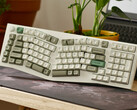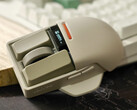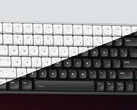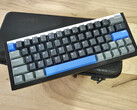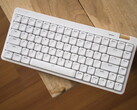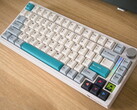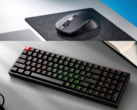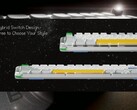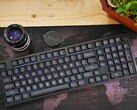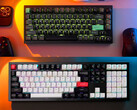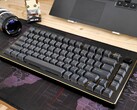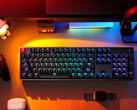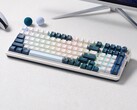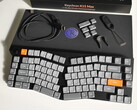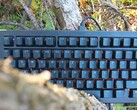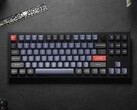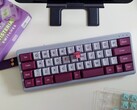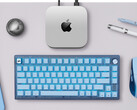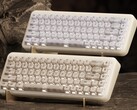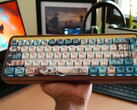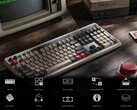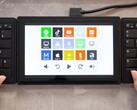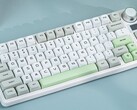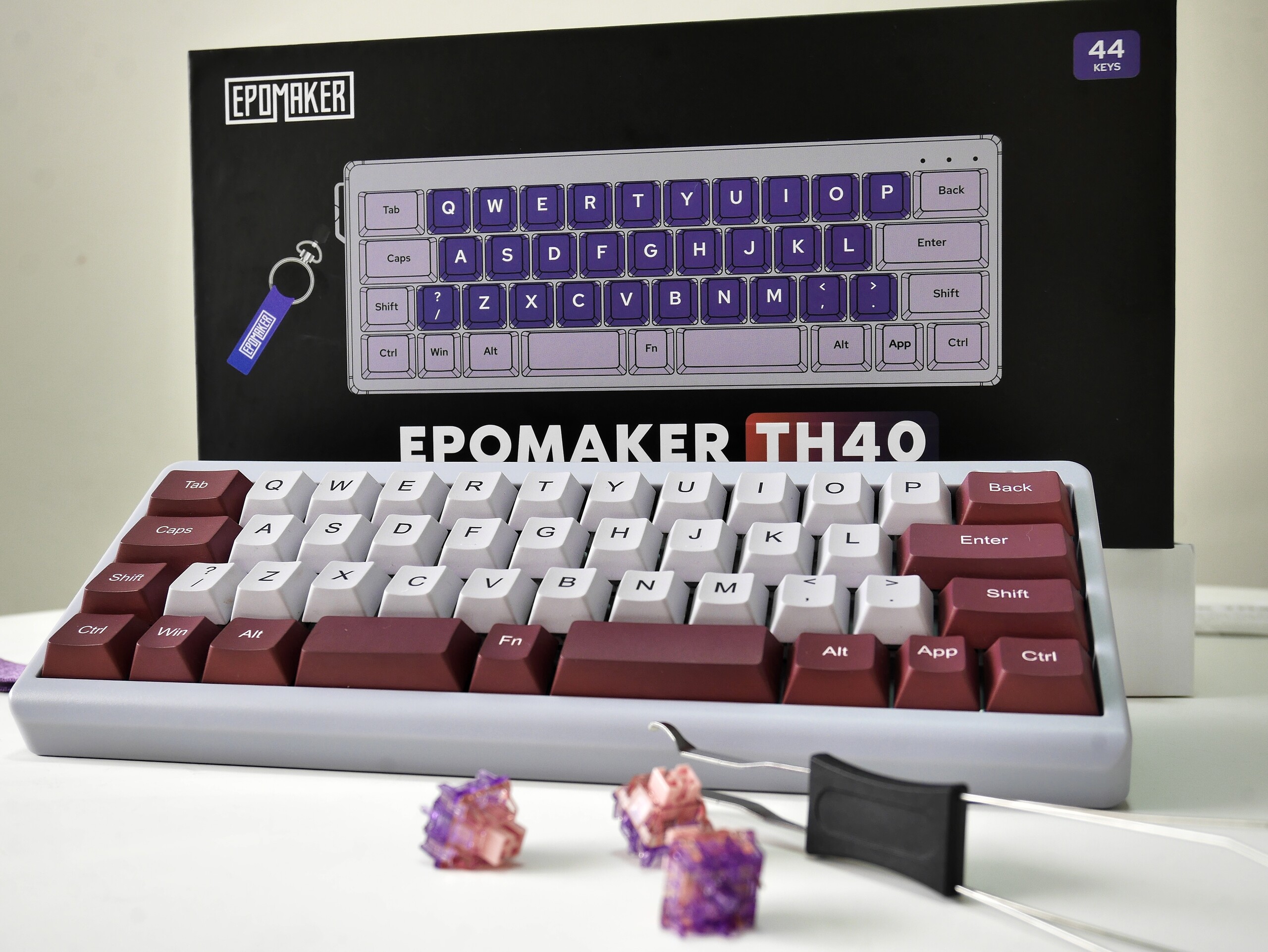
Epomaker TH40 hands-on review: Affordable 40% mechanical keyboard with big sound
Plastic fantastic
Epomaker's TH40 impresses in our hands-on review with outstanding battery life, a satisfying typing feel, and a rather pleasant sound profile. Caveat emptor, though, because it's not a perfect experience out of the box, and choosing the wrong config at checkout will result in disappointment.Julian van der Merwe, 👁 Enrico Frahn Published 🇫🇷 🇪🇸 ...
The Epomaker TH40 is a budget-orientated 40% mechanical keyboard for those who live by the mantra "less is more." It has an ABS plastic case, a variety of wired and wireless connectivity options, and 5-pin hot-swap switch sockets for easy customisability. By default, it ships with either Epomaker's Flamingo or Wisteria linear switches — a difference whose impact cannot be understated. At just $80 on Amazon or directly from Epomaker's online shop, it promises an affordable entry into the compact 40% mechanical keyboard market, but what compromises does Epomaker make to get the price so low, and does how does the unique 40% layout with split spaces bars work out in practical terms? We spent three weeks with the Epomaker TH40 for this review to find out.
| Feature | Details |
|---|---|
| Form factor and size | 40%, 44 keys, 258 × 97 × 35 mm |
| Case Material | ABS Plastic |
| Plate and mounting style | Polycarbonate plate and gasket mount |
| Connectivity | Bluetooth 5.0, 2.4 GHz, and USB type-C wired |
| PCB and switch style | 3/5-pin hot-swap PCB |
| Default Switch Options | Epomaker Flamingo or Wisteria linear mechanical switches | Layout | 40% semi-custom QWERTY layout with split space bars |
| Keycap material and profile | Dye-sublimated, double-shot PBT in Cherry profile |
| Customisation software | VIA browser-based application |
| Backlight | Per-key south-facing RGB backlighting |
| Polling rate | 1,000 Hz over 2.4GHz and wired, 125 Hz over Bluetooth |
| Price | $79.99 |
| Availability | Amazon and Epomaker's online shop |
Unboxing and accessories
Unlike the Wooting 80HE, which we recently reviewed, the Epomaker TH40 comes in a fairly conventional cardboard box that has a neat design printed on it but is otherwise uninspiring. At under $100, though, that's not unexpected for a mechanical keyboard. Protecting the keyboard in the box is some cheap polystyrene foam and a thin plastic bag — again adequate, but nothing to write home about.
Alongside the keyboard are the printed quick-start guide and another small cardboard box containing a keycap and switch puller, the compact 2.4 GHz receiver, and a 1.8 m long white braided USB type-C cable. Epomaker also included four extra Flamingo switches, in case issues arise with any of the switches pre-installed in the keyboard. Unlike Epomaker's other keyboards, there is no included allen key, which is indicative of the TH40's intended use case and assembly method, which will come up again later.
The included keycap and switch puller works fine, especially the wire keycap side, however, the switch puller feels a little flimsy, and the prongs were somewhat prone to bending if used a little too vigorously or on keyboards with switches that are a little more firmly held by the switch plate. Fortunately, the TH40's plastic plate doesn't hold the switches in place particularly firmly, so this isn't an issue.
Case and build quality
As alluded to previously, the TH40 is almost entirely made of plastic. The case is ABS, and it features a PC (polycarbonate) plate, but these material choices enhance the TH40's feel, rather than making it feel cheap. The case is designed in such a way that the seam is hidden on the underside of the board, so the TH40 looks and feels solid. Only under some rather severe pressure does the case emit any significant creaking or flex, which should never be a detriment to the day-to-day usage.
The TH40 has four rubberised feet, with two flip-out feet — also rubberised — at the back edge, allowing for two typing positions of 7 and 11 degrees. Both the flip-out feet feel sturdy enough. The left edge of the Epomaker TH40 has a similar removable carrying strap as is found on the Wooting 60HE, but the mounting hardware isn't actually removable, as it is on the Wooting, so taking it off leaves an odd plastic loop on the left bottom edge of the TH40. There also isn't a slot to store the 2.4 GHz dongle in the keyboard's case, making it prone to getting lost.
In terms of aesthetics, the TH40 is available in either the light greyish-lavender and purple colourway we were sent, simply called Purple on the Epomaker store, and Black Gold, which features a black case and mustard-yellow accent keycaps. Both Purple and Black Gold are likely to be somewhat divisive, although to different people and for different reasons. The TH40 in Purple is just begging to find a home in a cosy setup, but the black and yellow colourway will seem more at home in a more typical gamer setup or a study with a more serious aesthetic.
Keycaps
The keycaps on the TH40 are dye-sublimated PBT in a Cherry profile — although the change in key height is almost imperceptible, thanks to the small form factor — and, while the colour isn't too far off, the caps aren't perfectly colour-matched to the case, at least in the case of the purple colourway.
The darker purple accent keys aren't too loud, but they still give the TH40 an aesthetic flair it otherwise wouldn't have. The legend on the lavender keycaps in our review sample is a large, semibold, black script, and the dark purple keycaps have white lettering with a narrower script.
While the black lettering is crisp, there are faint fringes on the purple keycaps, although this is only noticeable on very close inspection and doesn't significantly affect the legibility or quality of the keycaps. The keycaps have a very fine matte texture on the top, which is, again, slightly different to the texture of the keyboard's case. All-in-all, the keyboard's keycaps and case complement each other well, aesthetically, even if the colour choices in our unit are somewhat unorthodox.
One feature that may be disappointing to some is that the TH40 features per-key RGB illumination, but the included keycaps are not shine-through, meaning RGB offers very little benefit, aside from the obvious aesthetic customisation. This can be remedied by enhancing the RGB with a set of shine-through keycaps, like this translucent Jade set for $36.99 or this set of smokey translucent Akko keycaps for $36.99.
Side-printed legends are the best fit because of the south-facing RGB configuration, although keycap sets that include a 2.25u and 2.5u split space bar configuration are not easy to find, so you may have to make a compromise and only change out the alpha keys. If you do buy the TH40 with the intention of swapping out the stock keycaps, an Alice layout keycap set should have all the necessary caps to fit the board.
Brilliant typing sound and feel let down by mediocre Flamingo switches
While ABS plastic may not sound like the stuff of premium mechanical keyboards, it does provide for an overall positive typing experience. The PC plate, flex-cut PCB, gasket mount, and ABS case soften the typing feel, although the effect of the gasket mount is almost imperceptible, likely helping more to isolate the PCB and plate from the case to dampen the sound. Depending on the switches you go with, the sound profile can be somewhat muted and on the lower end of the spectrum — somewhere between poppy and thocky.
The biggest issue with the Epomaker TH40's typing experience comes from Epomaker's choice of switches. Epomaker sent our review unit with the 35 gf Flamingo linear switches, which left a lot to be desired, even outside the realm of personal preference. While the Flamingo switches have the trappings of a good switch — with a PC top housing, POM (polyoxymethylene) stem, and factory lubrication creating a rather crisp, clacky sound profile — many of the switches in our TH40 felt slightly notchy in reality.
In comparison to Epomaker's own Jade Blossom linear switches, which can be had on Amazon for as little as $14.99 for a 30-pack, the Flamingo switches feel decidedly cheap. Along with the TH40, Epomaker sent us a set of Epomaker Wisteria tactile switches, which use the same design and materials as the Wisteria linear switches also available in the TH40, and those are leaps and bounds better than the Flamingo switches.
Below are some sound tests comparing three different Epomaker switches. In all of the audio samples, you can hear that the right space bar has some echo and a small amount of stabiliser rattle. Otherwise, all the stabilisers on the Epomaker TH40 are quiet and smooth, owing to generous factory lubrication.
Epomaker TH40 sound test with Flamingo linear switches
Epomaker TH40 sound test with Jade Blossom linear switches
Epomaker TH40 sound test with Zebra switches
The typing experience of the TH40 is also somewhat hampered by the default layout. Obviously, being a 40% keyboard, the TH40 is missing the F row, number row, and even a lot of essential punctuation. While the accommodations made by moving the [/?] key to the left side of the alpha section makes sense to maintain a standard QWERTY layout, and the split space bars and central Fn key make layering far more accessible and intuitive, the default layers seem more concerned with RGB configurations than anything else. By default, there is no way to add an apostrophe or quotation marks, and the F-row isn't bound to a layer, either.
Numbers are easily accessible with keys Q through P while holding the Fn key between the space bars, and the arrow cluster is bound to Fn + [>.]/[App]/[L Alt]/[L Ctrl] (for up, down, left, and right), but the second layer isn't set up for other functionality, like a navigation cluster or even delete. After we configured our layers, though, the TH40's split space bar layout quickly became comfortable to use and even made using a regular single space bar again somewhat challenging.
Notebookcheck has an upcoming article about how we set up the Epomaker TH40, and although this will also depend on preference, we found our configuration to make the 40% layout far more accessible and less intimidating for beginners.
Wireless connectivity and battery life
The Epomaker TH40 offers Bluetooth, 2.4 GHz, and USB type-C connectivity, with a switch on the back of the case to switch between modes. In 2.4 GHz and wired mode, the TH40 has a polling rate of 1,000 Hz, making it acceptable for gaming. Bluetooth drops the polling rate down to 125 Hz, which would add a whole 8 ms of latency to the input pipeline, making that connection mode a poor choice for gamers.
Whether connecting to Linux or Windows via the TH40's included 2.4GHz dongle or to Android via Bluetooth 5.0, the TH40 impresses with worry-free battery life and connectivity. It pairs to the device quickly with the built-in shortcuts, and can store three Bluetooth hosts in the on-board memory. Switching between the Bluetooth devices is also dead simple, thanks to the Fn+ A/S/D shortcut combination — corresponding to devices one, two, and three, respectively.
Bluetooth switching and pairing happened flawlessly and quickly, with connections taking around a second after the first time the keyboard was paired. We also didn't notice any repeated letters or lag caused by the wireless connectivity, and the connection was always stable at a reasonable distance from the host device.
The Epomaker TH40 comes equipped with a 3,000 mAh battery, and while that might not sound like much, coming from the world of laptops and smartphones, it has proven itself to be plenty during our review period. In our three-week testing period with the TH40, it has only been charged to 100% once, and that was to top it off to test the battery drain.
While precise battery life testing with a complete drain from 100% to 0% is outside the scope of this review, we were able to test battery drain in terms of percentage drain per hour, which we can extrapolate into an estimated battery life figure.
We tested the TH40 in a number of configurations, resulting in these estimates:
- Bluetooth connection with RGB at around 50%: 2.5% battery drain per hour, or around 40 hours of usable battery life.
- 2.4 GHz connection with RGB at 100%: around 5% battery drain per hour, or about 20 hours of continuous use.
- 2.4 GHz with RGB off: around 1.5% battery drain per hour, or an estimated 67 hours of use.
Overall, the battery in the Epomaker TH40 has been impressive, and using Bluetooth with the RBG lights off resulted in battery drain so low that it initially seemed like the keyboard was incorrectly reporting battery percentage. As it turns out, using the TH40 via Bluetooth with the RGB off drained the battery by a whopping 1-2% per day, which consisted of around six hours of writing and around 4 hours of intermittent general use.
It should be noted that the Bluetooth testing was conducted using a OnePlus Pad, running Android, since that provided the easiest way to monitor the keyboard's battery life. This is likely pretty close to a best-case scenario, however, and the TH40's size makes it almost perfect for this exact use case.
Regardless of which device the TH40 is connected to, when it is connected wirelessly, it enters sleep after exactly five minutes of inactivity, but when a button is pressed, the keyboard immediately springs back to life, and the keypress is even registered correctly on the connected device.
Software customisation is sorely needed, but VIA support is spotty
While Epomaker claims the TH40 is VIA compatible, thanks to QMK firmware, it's not a flawless experience, unfortunately. In order to use VIA, you need to enable V2 definitions in VIA, which is technically a compatibility mode, and upload a JSON layout file available from the Epomaker website. After that, VIA should be able to recognise the TH40, and you should be able to remap the keys and configure layers.
Speaking of customisation, the single biggest issue with the Epomaker TH40 is that is it very difficult to use as a daily driver straight out of the box, thanks to its stock key bindings and layer configuration, as highlighted in the typing section above. However, it only took about an afternoon of customising the TH40 with VIA to regain all the functionality of a full-size keyboard. Learning to type with the altered layout, though, took some getting used to, but after about two days it was easy enough to remember where different keys were on the other layers, but by the end of the first week, it became fairly easy to match or even surpass typing speed from past keyboards.
This has more to do with the 40% layout than the TH40 itself, but subjectively, the TH40 does feel more efficient than typing on a full-size or TKL keyboard, especially if you are prone to "getting lost" on bigger keyboards or misplacing your hands on the home row. With the TH40, there's just not enough space for your hands to get lost, and the compact nature of the keyboard makes it very easy to index using a keyboard edge or bezel.
TH40 disassembly - not made for modification
While software customisation is possible, and even necessary for the Epomaker TH40, it's clear that Epomaker intends its customers to use the TH40 in its default hardware configuration, which is actually not a terrible prospect in this case. Unlike many other Epomaker mechanical keyboards, and others still from other manufacturers, there is not a screw to be seen on the Epomaker TH40.
Everything here is held together with clips, and the case is rigid enough that you'll need a spudger tool or sacrificial credit card to open the keyboard. Even then, during our second disassembly of the TH40, one of the clips bit the dust. Fortunately, the case still closes rather firmly, even with one less clip.
While clips are annoying, and the majority of keyboard fanatics would rather they be avoided completely, the relatively low price of the TH40 justifies their use here, since screws would add extra length to the assembly time, increasing the production cost. Clips also help keep the weight low, which also seems to have been one of Epomaker's goals, likely in the name of portability.
Once inside the TH40's case, you can see the PCB foam, plate foam, foam gasket mounting system, and not very much else. Another problem arises when trying to modify the TH40. Almost any attempt at removing the PCB foam from the back of the PCB results in tearing, and it takes an inordinate amount of patience and dexterity to ultimately remove the PCB foam.
If you do get as far as to remove the PCB foam, though, you'll notice that it doesn't actually change the sound profile all that much, only marginally increasing the volume of bottoming out key strokes. We didn't go so far as to test this, at least not yet, but you can likely mute the TH40's already rather quiet sound profile further by adding more sound-damping materials to the empty space in the bottom case.

Issues with the TH40
During our testing with the Epomaker TH40, we encountered two somewhat serious issues, the more serious of which we were able to fix on our own. On about the fifth day of testing, the OnePlus Pad we were using to test wireless connectivity restarted with the keyboard connected. For some reason, this caused the TH40 to spiral into a crash. For whatever reason, following this incident, it would no longer show up on any device with the Bluetooth device 1 connection. Fortunately, this was a simple fix using the firmware update .exe file from Epomaker's website. Unfortunately, though, this meant that all the custom key mapping and customisation we had done was deleted, so it had to be reprogrammed in VIA using screenshots as references.
The other major issue revolves around the use of macros, while the TH40 accepts macros recorded in VIA, attempting to edit macro code in VIA always resulted in an error, even if the key codes were pasted from a different part of the recorded macro string. This is a limitation likely introduced by the V2 VIA definitions that the TH40 uses, but it is easy enough to work around in most situations, unless you're trying to program a macro that contains keys you don't physically have on your keyboard or on another keyboard nearby.
Our specific production unit of the Epomaker TH40 also had an issue that caused VIA to incorrectly read the information stored on the keyboard, meaning the “Macro 1” slot would be overwritten by the default demo macro every time changes were made in a new VIA session after assigning the original macro.
Epomaker assures us that this is not standard behaviour, but it's part of the reason we'll be recommending ordering the TH40 from Amazon if you do plan on buying one. I also spoke to a colleague who reviewed the TH40 for another publication, and he confirmed that he experienced no such issues, so it doesn't seem like a design flaw, rather a QC or manufacturing problem that slipped through the cracks.
Pros
Cons
Verdict - an excellent 40% keyboard with one massive caveat
Minor niggles aside, the Epomaker TH40 has been a pleasure to work with and type on and use, even if the lack of software polish leaves something to be desired. Its impressive battery life makes using the keyboard in wireless mode worry-free, and the customisation with VIA helped take the TH40 from a cute curiosity to a keyboard as much a workhorse as any other. Its light weight, solid, compact build quality, and relatively tame but charming looks also make it an ideal candidate for a portable mechanical keyboard.
The Epomaker TH40 is available from Amazon for $79.99 in both Purple and Black Gold, and with either the Wisteria or Flamingo linear switches. We recommend getting the keyboard from Amazon, as opposed to Epomaker's site, since the price is the same, regardless where you buy, and Amazon at least provides easy returns in the case of any potential issues.
The TH40 is not for the faint of heart — it takes some serious customisation and adjustment before it's anything close to ideal.
As far as usability goes, the TH40 is definitely for the more adventurous and tech-savvy user, making it difficult to recommend to casual gamers or average PC users, due to its lack of dedicated number and function keys. That said, after setting up the layers in a way that makes sense, it is fairly easy for just about anyone to get used to the diminutive 40% form factor, largely thanks to the more conventional row-staggered QWERTY layout. The TH40 is not for the faint of heart — it takes some serious customisation and adjustment before it's anything close to ideal.
Transparency
The selection of devices to be reviewed is made by our editorial team. The test sample was provided to the author as a loan by the manufacturer or retailer for the purpose of this review. The lender had no influence on this review, nor did the manufacturer receive a copy of this review before publication. There was no obligation to publish this review. As an independent media company, Notebookcheck is not subjected to the authority of manufacturers, retailers or publishers.




